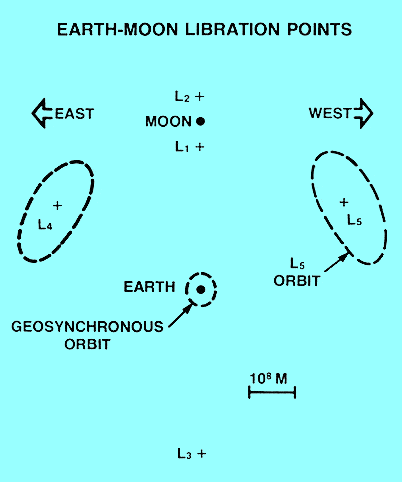L5: A Place in Space
by T.A. Heppenheimer, author of Colonies in Space
(The following diagram and description appeared in many issues of the L5 News)

L5 is the fifth Lagrangian Libration point. But what are libration points? They are locations where a spacecraft may be placed so as always to remain in the same position with respect to the Earth and the Moon.
The French mathematician, Lagrange, in 1772, showed that there are five such points. Three of them lie on a line connecting the Earth and Moon; these are L1, L2, and L3. They are unstable; a body placed there and moved slightly will tend to move away, though it will not usually crash directly onto the Earth or Moon. The other two are L4 and L5. They lie at equal distance from Earth and Moon, in the Moon’s orbit, thus forming equilateral triangles with Earth and Moon. The Sun is in the picture, and it disturbs the orbits of spacecraft and colonies. It turns out (from an extremely messy calculation done only in 1968) that with the Sun in the picture, a colony could be placed not directly at L4 or L5, but rather in an orbit around one of these points. The orbit keeps the colony about 90,000 miles from its central libration point.
But what has people excited is not what orbit might be used, but rather what could be done there. Space industries in high Earth orbits could manufacture solar power satellites (SPS) from lunar or asteroidal resources. Each SPS could deliver twice as much low cost, environmentally safe energy to Earth, via microwaves, as the Grand Coulee Dam, and forty five of them could meet the total present electrical power needs of the U.S.
This activity would create tens of thousands of jobs in space as well as on Earth within as short a time as 15 years, and getting tens of thousands of us living and working in space is the goal of the L5 Society.







